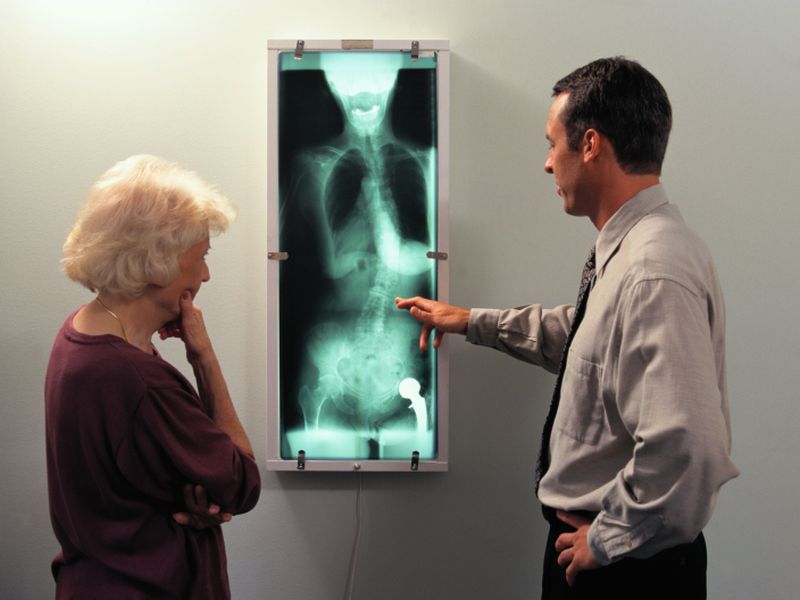Spinal Fusion Not Always Necessary for Back Pain, Studies Say
Some patients may benefit from a simpler procedure called decompression
HealthDay Reporter

WEDNESDAY, April 13, 2016 (HealthDay News) -- Spinal fusion surgery is too often used to treat lower back pain when a simpler procedure would suffice for many patients, according to a pair of new clinical trials.
People suffering from spinal stenosis -- pinched nerves caused by a narrowing of the spinal canal -- received similar pain relief with fewer complications when doctors performed a simpler spine surgery called decompression, as opposed to a full-fledged spinal fusion, a study from Sweden found.
"Fusion was associated with longer operating time, longer hospital stay and was more expensive than decompression alone," said lead researcher Dr. Peter Forsth, an orthopedic surgeon with the Stockholm Spine Center.
However, certain patients would do better with a spinal fusion, the other clinical trial concludes.
That trial found that spinal fusion provided better results for low-back pain patients who have pinched nerves because a spinal bone slipped forward and out of place, a condition called lumbar spondylolisthesis.
"Adding a lumbar fusion resulted in superior health-related quality of life two, three and four years after surgery" for patients with back pain due to a slipped vertebra, said lead researcher Dr. Zoher Ghogawala. He is a neurosurgeon with Lahey Hospital and Medical Center's Spine Research Center in Burlington, Mass.
The upshot of the two clinical trials is that spinal fusion should not be used to treat every person with pinched nerves in their lower back, Ghogawala said.
Based on the Swedish results, "there's really no benefit associated with adding a spinal fusion for patients who have stenosis without malalignment," Ghogawala said. "What our study did was, we focused entirely on patients who had a malalignment of their spine, and we found they had better outcomes with spinal fusion."
Lower back pain often occurs due to the aging and degeneration of the discs, ligaments and joints that hold the spine together, Ghogawala and Forsth said.
"A combination of those processes narrows the area of the spinal canal, where the nerves live, and those nerves that get crowded and compressed can cause pain," Ghogawala said.
Decompression surgery relieves the pressure on those nerves by removing the lamina, or the back part of the vertebra that covers the spinal canal. This surgery is also known as laminectomy.
Surgeons often supplement decompression surgery with spinal fusion to reduce the risk that the spine will continue to degenerate and require another operation, the Swedish researchers said in background notes.
Spinal fusion permanently joins two or more bones in the spine, according to the U.S. National Institutes of Health. The fusion is done with bone grafts, using rods, screws or plates to keep the spinal bones from shifting until the grafts are healed.
The two new studies were published April 14 in the New England Journal of Medicine.
The Swedish trial involved 247 patients aged 50 to 80 years with back pain due to narrowing of the spinal canal (stenosis). About half also had a slipped vertebra (spondylolisthesis). All were randomly assigned to receive either decompression surgery alone or decompression with fusion.
Researchers found no significant differences in quality of life or ability to walk between the groups, at either two or five years following surgery. The proportion who required follow-up surgery was also about the same -- 22 percent for fusion patients and 21 percent for decompression patients.
But fusion patients required 7.4 days of hospitalization on average versus 4.1 days for decompression patients. Fusion patients also needed longer time in the operating room, lost more blood, and had higher surgical costs, the study found.
In the U.S. trial, researchers assigned 66 patients, average age 67, to either fusion or decompression. But their trial focused solely on patients whose squeezed spinal nerves were caused by slipped vertebrae (spondylolisthesis).
The researchers found that the fusion group had a significantly better quality of life as much as four years following surgery, compared with the decompression group.
Ghogawala added that people who received spinal fusion were less likely to need a follow-up surgery: about 14 percent compared with 34 percent of those in the decompression-only group.
These studies demonstrate that spinal fusion is not automatically preferable to simple decompression surgery, said Dr. Alan Hilibrand, co-director of spine surgery for the Rothman Institute and a professor of orthopedic surgery at Thomas Jefferson University in Philadelphia.
"It's not a settled issue," Hilibrand said. "A lot of people would say it's a settled issue -- if there's a slip of the vertebrae, you do a fusion. These studies say, maybe not."
Doctors in the United States likely will continue to lean towards fusion because there are better chances for durable results, Hilibrand said.
However, these studies show that use of fusion should be more nuanced, Hilibrand suggested.
"These studies are great, because they're going to push people to look at this question," he said. "We haven't figured out which patients don't need fusion and which do."
More information
For more on spinal stenosis, visit the U.S. National Institutes of Health.
SOURCES: SOURCES: Peter Forsth, M.D., Ph.D., orthopedic surgeon, Stockholm Spine Center, Sweden; Zoher Ghogawala, M.D., neurosurgeon, Lahey Hospital and Medical Center, Spine Research Center, Burlington, Mass.; Alan Hilibrand, M.D., co-director of spine surgery, Rothman Institute, and professor, orthopedic surgery, Thomas Jefferson University, Philadelphia; April 14, 2016, New England Journal of Medicine
Last Updated: Wednesday, April 13, 2016 9:14:54 PM EDT
Copyright © 2016 HealthDay. All rights reserved.